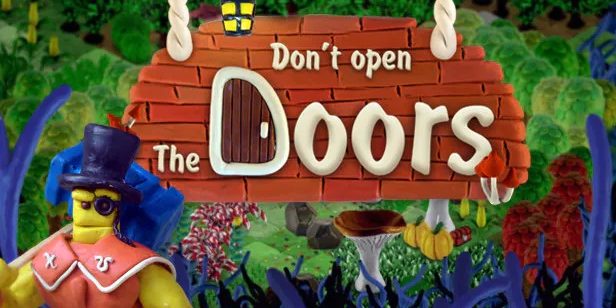I’ve always had a soft spot for claymation, the animation technique that uses stop motion and clay, especially since it seems to easily be synonymous with “weirdness”. In cinema, one of the masters of claymation is Jan Svankmajer, in gaming most people would refer to The Neverhood series of titles (provided that few people know there was a third title after Skullmonkeys). There have been other lesser-known, but equally peculiarly designed adventure games like The Dark Eye and, more recently, The Dream Machine.
Don’t Open the Doors is one of the few modern plasticine-infused isometric action adventures with light RPG elements that seems to harken back to classic 90s game design. But is it actually any good?
Designed by Anton Riot, one-man Russian developer who did everything except for the soundtrack, DotD’s claymation took close to 8000 different photos to make and is entirely handcrafted. Luckily, that very same care and attention seem to translate to the gameplay. While the design doesn’t really try anything new or original, it is a well-balanced action adventure with light RPG elements: explore, dispose of enemies, earn money, buy items, unlock doors and progress through the story.
The dialogues are mostly there for laughs, with hatred-filled pumpkins, bugs that go through their boring lives, talking objects, and an array of quirky, but mostly one-dimensional, characters. While, for the most part, dialogues flow naturally, some phrases seem to have suffered a bit during translation. The story and gameplay design are pretty simple, which is not a bad thing per se, since it is better to have a solid set of gameplay features, rather than overshooting the moon with exaggerated mechanics. While the keyboard & mouse combination works fine for an isometric title, it is, unfortunately, impossible to rebind any of the controls. It is a control scheme that – at times – brings the gameplay close to that of a hack’n’slash and, yes, it does really play like a Diablo clone at times. Along with constantly being aware of enemies, it is also possible to destroy most of the items found in the level with blows from the hammer, in order to search for useful items or anything of value that can be sold to merchants.
But in reality, Don’t Open the Doors’ main inspiration for the mix of linear progress and exploration seems to be the tried and true gameplay of Little Big Adventure. Coherently with its status as an homage to 90s classics, the title seems to bring along some of the typical frustrations of DOS games from that very same era. But this seemed not to be a conscious choice by Anton Riot: it’s draconically required that the player adapts to its framework and design in order to progress. While the difficulty never really skyrockets, the player must fully recognize and digest most of the title’s quirks to progress.
The hero’s main attack animation is inherently slow and gets interrupted each time he is hit, thus enemies that melee attack – really most of them – will always have the upper hand. The player has to adapt and overcome the problem by planning ahead and avoiding large numbers of foes unless a very powerful weapon has been collected. The worst enemies are the basic flies, not really because they deal a massive amount of damage, but in large numbers, they can halve the hero’s life in a few seconds. Retreat or a massive usage of bombs are the only viable option when cornered. Collecting the gun lessens the problem somewhat, but never really solves it, since, even in the later stages, it is easy to be overwhelmed by a neverending swarm of flies even with an upgraded character.
A different design for the enemies or a selection of more effective melee weapons would have gone a long way in making the gameplay feel less frustrating and more palatable for the general public. While progress is usually linear, exploring any of the open doors, while apparently not necessary, ends up being required: those brief snippets of more intense action Rpg gameplay that await behind them will award the player’s a new ability or a health upgrade. While I recognize the smart choice to transform the repetitive grinding into something that feels more rewarding, pushing the player to explore some of the doors without being actually forced to, might have made more sense.
The decision to make Don’t Open the Doors! in plasticine was indeed the right one: it adds a whole lot of personality to what would otherwise be an unremarkable and unnamed world. Along with the weird dialogues and talking objects that seem to be there just to sprout profanity, this definitely feels like a one-man indie game through and through. It is actually the weirdness of the whole experience that kept me coming back even though some frustrations in the gameplay. The soundtrack is also pretty coherent with the graphics, a mix of folk and industrial hard rock that, while perhaps not as varied as one might hope, definitely fits snugly with the world’s eccentricity.
Don’t open the Doors succeeds in combining a quirky gameworld and a tried and true gameplay with enough variety and challenge. Shame about the little design problems that don’t seem like they are going to be patched anytime soon since Anton is busy on an early access title (which after three years will probably not be released anytime soon), also made with clay, which takes the same gameplay and brings it to multiplayer: Disdoored. For an 8/10 hour game, DotD does not overstay its welcome and may just what the doctor ordered for several nostalgic players.
Thank you for reading.
If you wish to help keep the website alive and running, be sure to check out my patreon or offer me a coffee.






I wonder what happened with Disdoored, publisher is different and it never got many updates, forever stucked in Early Access limbo.